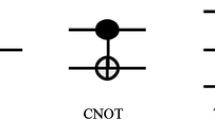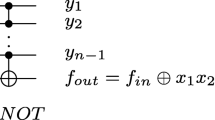Abstract
DNA computing has attracted the attention of many a researcher in recent years for its applicability to solve computationally hard problems. It can over-perform conventional computers with its inherent massively parallelism nature. On the other hand, proper synthesis of reversible circuit is a well researched computing problem in recent days for its extremely low power consumption (ideally zero) and inherent reversible nature of reversible logic. Minimum synthesis of a reversible truth table means finding the reversible circuit made up of reversible gates satisfying given truth table with minimum cost. But none of the approaches running on conventional computers can perform minimum synthesis till date without using brute-force DFS tree search. On the other hand, DFS tree-search approach can not be reasonably implemented for larger circuits as searching a DFS tree is extremely costly on a conventional computer. In this paper, first, a procedure to search a DFS tree in constant time has been proposed to run on a DNA computer. Second, another procedure has also been proposed to apply a reversible gate on a reversible truth table in linear time that can be used to generate a DFS tree library. Finally, the generated library can then be searched in constant time to get minimum reversible circuit given a reversible truth table. An analytical feasibility study has been done and a novel methodology has been developed that can extend enormous scope of future research in this area. To the best of authors’ knowledge this is a pioneering approach to bridge reversible computing and DNA computing.




Similar content being viewed by others
References
Adleman LM (1994) Molecular computation of solutions to combinatorial problems. Science 266:1021–1024
Al-Rabadi AN (2004) Reversible logic synthesis: from fundamentals to quantum computing. Springer, New York
Benenson Y, Gil B, Ben-Dor U, Adar R, Shapiro E (2004) An autonomous molecular computer for logical control of gene expression. Nature 429:423–429
Bonnet J, Yin P, Ortiz ME, Subsoontorn P, Endy D (2013) Amplifying genetic logic gates. Science 340(6132):599–603
Boneh D, Dunworth C, Lipton RJ (1995) Breaking DES using a molecular computer. In: DIMACS workshop on DNA computing
Braich RS, Chelyapov N, Johnson C, Rothemund PWK, Adleman L (2002) Solution of a 20-variable 3-SAT problem on a DNA computer. Science 296:499–503
De Vos A (2011) Reversible computing: fundamentals, quantum computing, and applications. Wiley, New York
Fujiwara A, Matsumoto K, Chen W (2003) Addressable procedures for logic and arithmetic operations with DNA strands. In: International Parallel and Distributed Processing Symposium, 2003
Goldman N, Bertone P, Chen S, Dessimoz C, LeProust EM, Sipos B, Birney E (2013) Towards practical, high-capacity, low-maintenance information storage in synthesized DNA. Nature 494:77–80
Garey MR, Johnson DS (1979) Computers and intractability: a guide to the theory of NP-completeness. W. H. Freeman & Co., San Francisco
Gupta P, Agrawal A, Jha N (2006) An algorithm for synthesis of reversible logic circuits. IEEE Trans Comput Aided Des Integr Circuits Syst 25(11):2317–2330
Harlan Wood D, Chen J (2004) Fredkin gate circuits via recombination enzymes. In: Congress on evolutionary computation, 2004, vol 2. CEC2004, pp 1896–1900
Huang PJJ, Liu J (2013) Separation of short single- and double-stranded DNA based on their adsorption kinetics difference on graphene oxide. Nanomaterials 3(2):221–228
Li Z, Chen H, Yang G, Liu W (2013) Efficient algorithms for optimal 4-bit reversible logic system synthesis. J Appl Math. doi:10.1155/2013/291410
Lipton RJ (1995) DNA solution of hard computational problems. Science 268:542–545
Liu Y, Xu J, Pan L, Wang S (2002) DNA solution of a graph coloring problem. J Chem Inf Comput Sci 42:524–528
Livshits GI, Stern A, Rotem D, Borovok N, Eidelshtein G, Migliore A, Penzo E, Wind SJ, Di Felice R, Skourtis SS, Cuevas JC, Gurevich L, Kotlyar AB, Porath D (2014) Long-range charge transport in single G-quadruplex DNA molecules. Nat Nanotechnol. doi:10.1038/nnano.2014.246
Lovgren S (2003) Computer Made from DNA and Enzymes. National Geographic News 24. http://news.nationalgeographic.com/news/2003/02/0224_030224_DNAcomputer.html
Miller D, Maslov D, Dueck G (2003) A transformation based algorithm for reversible logic synthesis. In: Proceeding of design automation conference, pp 318–323
Ouyang Q, Kaplan PD, Liu S, Libchaber A (1997) DNA solution of the maximal clique problem. Science 278:446–449
Reif JH (1995) Parallel biomolecular computation: models and simulations. Algorithmica 25(21):322–323
Saeedi M, Zamani MS, Sedighi M, Sasanian Z (2010) Reversible circuit synthesis using a cycle-based approach. J Emerg Technol Comput Syst 6(4):13:1–13:26
Sanches CAA, Soma NY (2009) A polynomial-time DNA computing solution for the bin-packing problem. Appl Math Comput 215:2055–2062
Sarker A, Ahmed T, Rashid S, Anwar S, Jaman L, Tara N, Alam M, Babu H (2011) Realization of reversible logic in dna computing. In: 2011 IEEE 11th international conference on bioinformatics and bioengineering (BIBE), pp 261–265
Shende VV, Prasad AK, Markov IL, Hayes JP (2002) Reversible logic circuit synthesis. In: Proceedings of the 2002 IEEE/ACM international conference on computer-aided design. ACM, pp 353–360
Shende V, Prasad A, Markov I, Hayes J (2003) Synthesis of reversible logic circuits. IEEE Trans Comput Aided Des Integr Circuits Syst 22(6):710–722
Song T, Wang S, Wang X (2008) The design of reversible gate and reversible sequential circuit based on DNA computing. In: 3rd international conference on intelligent system and knowledge engineering, 2008, vol 1. ISKE 2008, pp 114–118
Thapliyal H, Srinivas MB (2006) An extension to DNA based fredkin gate circuits: design of reversible sequential circuits using fredkin gates. CoRR abs/cs/0603092. http://arxiv.org/abs/cs/0603092
Tsai S, Chang WL, Ho SH (2007) Constructing bio-molecular parallel adder with basic logic operations in the Adleman–Liption model. In: International conference on convergence information technology 2007, pp 925–930
Wille R, Drechsler R (2009) BDD-based synthesis of reversible logic for large functions. In: Design automation conference, pp 270–275
Wille R, Drechsler R (2010) Towards a design flow for reversible logic. Springer, New York
Xiao D, Li W, Yu J, Zhang X, Zhang Z, He L (2006) Procedures for a dynamical system on \(\{0,1\}^n\) with DNA molecules. Biosystems 84(3):207–216
Yazdi SHT, Yuan Y, Ma J, Zhao H, Milenkovic O (2015) A rewritable, random-access DNA-based storage system. Sci Rep. doi:10.1038/srep14138
Author information
Authors and Affiliations
Corresponding author
Rights and permissions
About this article
Cite this article
Sarkar, M., Ghosal, P. & Mohanty, S.P. Minimal reversible circuit synthesis on a DNA computer. Nat Comput 16, 463–472 (2017). https://doi.org/10.1007/s11047-016-9553-6
Published:
Issue Date:
DOI: https://doi.org/10.1007/s11047-016-9553-6




